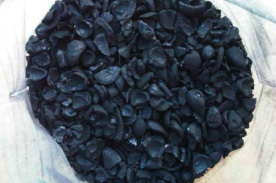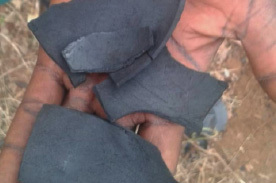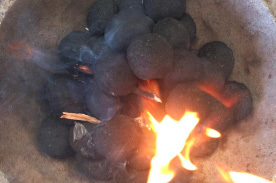

Charcoal is a lightweight black carbon residue produced by removing water and other volatile content from organic materials. The advantage of burning charcoal compared to burning wood is the absence of water and other components. This allows charcoal to burn at higher temperatures, and emit very little smoke. Regular wood might release a significant amount of steam, organic volatiles, and unburnt carbon particles (soot) in its smoke, when it is not burned completely.
The production of wood charcoal in locations where there is an abundance of wood dates back to ancient times. It generally begins with piling billets of wood on their ends to form a conical pile. Openings are left at the bottom to admit air, with a central shaft serving as a flue. The whole pile is covered with turf or moistened clay. The massive production of charcoal (at its height employing hundreds of thousands, mainly in Alpine and neighbouring forests) was a major cause of deforestation, especially in Central Europe.
Complaints about shortages may relate to the results of temporary over-exploitation or the impossibility of increasing production to match growing demand. The increasing scarcity of easily harvested wood was a major factor behind the switch to fossil fuel equivalents, mainly coal and brown coal for industrial use.

Palm Kernel Shell Charcoal. The carbon content is more than 80%.
Charcoal is usually produced by slow pyrolysis, i.e. the heating of wood or other organic materials in the absence (or low level) of oxygen. This process is called carbonisation. The final charcoal consists of a high level of carbon.
The "conversion ratio", i.e. how mamy kilograms of raw material are needed for 1 kilogram charcoal, depends mainly on two factors:
The carbon content of Palm Kernel Shells is around 50% while in Coconut Shells around 40%. This gives a theoretically conversion ratio at 2 and 2.5, i.e. it takes at least 2 kg of raw Palm Kernel Shells to make 1 kg charcoal and 2.5 kg of raw Coconut Shells to make 1 kg charcoal.
However, to get anything close to the theoretical conversion rate takes a very expensive production system. One of the main requirements is a vacuum oven to make sure that none of the shells get on fire. If doing the carbonisation process "the old fashion way" in petrol drums, the conversion ratio is around 5 kg raw material for 1 kg charcoal for both Palm Kernel Shells and Coconut Shells.

Coconut Shell Charcoal. The carbon content is close to 80%.
| Parameter | Value |
|---|---|
| Moisture | 0% |
| Ash | 0.10% |
| Carbon | 99.2% |
| Gross Calorific Value | 5,650 kWh/MT - 20.35 GJ/MT |
| Net Calorific Value | 5,300 kWh/MT - 19.10 GJ/MT |
| Parameter | Value |
|---|---|
| Moisture | 10% |
| Ash | 5% |
| Carbon | 78.8% |
| Gross Calorific Value | 5,650 kWh/MT - 20.35 GJ/MT |
| Net Calorific Value | 5,300 kWh/MT - 19.10 GJ/MT |

Briquettes. Both Palm Shell Charcoal and Coconut Charcoal are available as briquesttes.